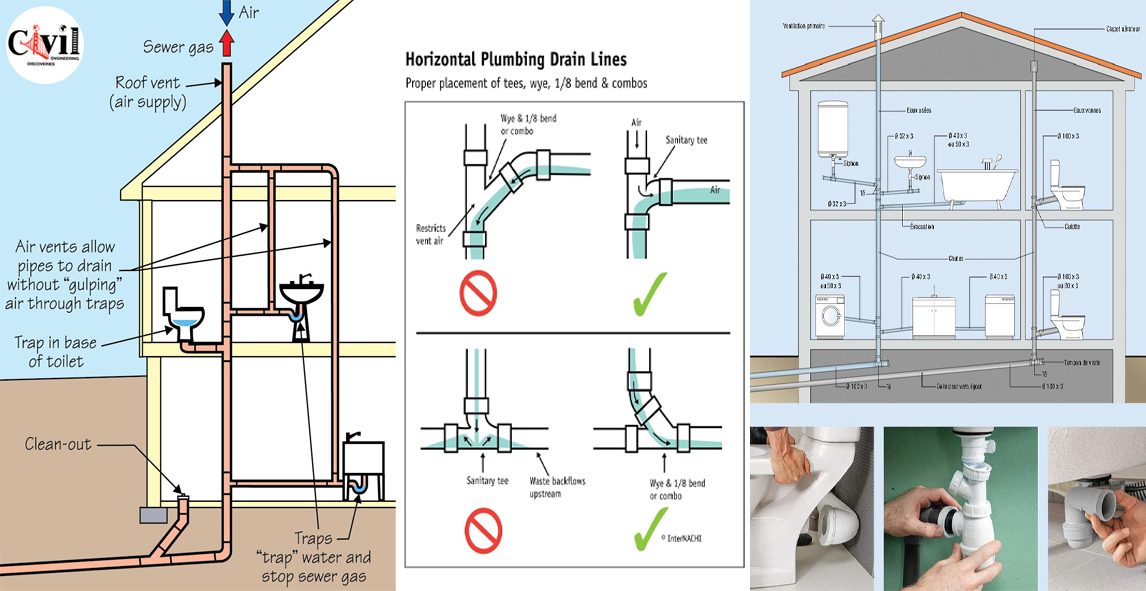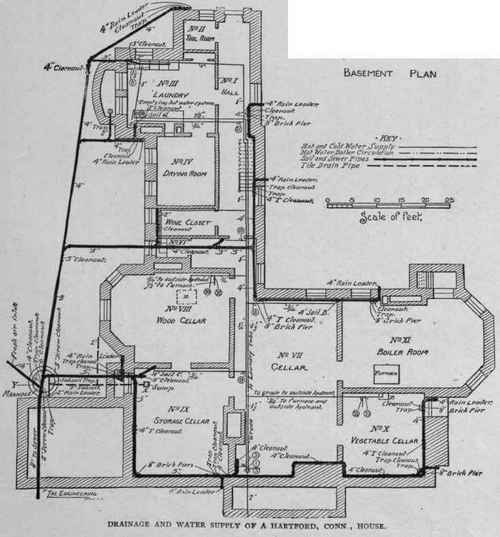How Your Home's Plumbing System Works: Design
How Your Home's Plumbing System Works: Design
Blog Article
We have discovered the article pertaining to Plumbing Installation 101: All You Need to Know below on the net and think it made good sense to share it with you over here.

Recognizing how your home's plumbing system works is necessary for every single home owner. From supplying tidy water for drinking, cooking, and bathing to safely eliminating wastewater, a well-kept plumbing system is essential for your household's health and wellness and comfort. In this extensive guide, we'll explore the intricate network that makes up your home's plumbing and offer pointers on maintenance, upgrades, and dealing with common problems.
Introduction
Your home's pipes system is greater than just a network of pipes; it's a complicated system that guarantees you have access to clean water and efficient wastewater removal. Understanding its parts and how they work together can assist you stop pricey fixings and make certain every little thing runs smoothly.
Fundamental Parts of a Pipes System
Pipelines and Tubes
At the heart of your plumbing system are the pipes and tubing that carry water throughout your home. These can be made from different products such as copper, PVC, or PEX, each with its benefits in regards to longevity and cost-effectiveness.
Fixtures: Sinks, Toilets, Showers, etc.
Fixtures like sinks, toilets, showers, and bath tubs are where water is made use of in your house. Recognizing exactly how these fixtures connect to the plumbing system helps in diagnosing issues and planning upgrades.
Shutoffs and Shut-off Points
Shutoffs manage the circulation of water in your plumbing system. Shut-off valves are vital during emergency situations or when you require to make repair services, allowing you to separate parts of the system without disrupting water circulation to the whole residence.
Supply Of Water System
Main Water Line
The major water line attaches your home to the metropolitan water or an exclusive well. It's where water enters your home and is dispersed to different components.
Water Meter and Stress Regulatory Authority
The water meter procedures your water use, while a stress regulatory authority makes sure that water moves at a secure pressure throughout your home's plumbing system, stopping damages to pipelines and components.
Cold Water vs. Warm water Lines
Comprehending the distinction in between cold water lines, which supply water directly from the major, and hot water lines, which bring heated water from the water heater, aids in troubleshooting and preparing for upgrades.
Drain System
Drain Water Lines and Traps
Drain pipes carry wastewater far from sinks, showers, and bathrooms to the sewer or septic system. Catches avoid sewage system gases from entering your home and likewise trap debris that can trigger clogs.
Ventilation Pipelines
Ventilation pipes enable air into the water drainage system, stopping suction that might slow water drainage and trigger catches to vacant. Proper ventilation is important for maintaining the honesty of your plumbing system.
Relevance of Proper Water Drainage
Making sure proper water drainage avoids back-ups and water damages. Routinely cleansing drains and keeping traps can protect against expensive fixings and prolong the life of your pipes system.
Water Heater
Sorts Of Water Heaters
Hot water heater can be tankless or conventional tank-style. Tankless heating systems warm water as needed, while tanks save heated water for prompt use.
Updating Your Plumbing System
Reasons for Updating
Upgrading to water-efficient components or replacing old pipelines can improve water high quality, lower water expenses, and increase the value of your home.
Modern Pipes Technologies and Their Benefits
Check out technologies like wise leakage detectors, water-saving toilets, and energy-efficient hot water heater that can save money and lower environmental effect.
Cost Factors To Consider and ROI
Determine the upfront expenses versus lasting savings when thinking about pipes upgrades. Many upgrades pay for themselves with lowered utility expenses and less repairs.
Exactly How Water Heaters Link to the Pipes System
Comprehending just how hot water heater connect to both the cold water supply and hot water circulation lines aids in diagnosing issues like inadequate warm water or leakages.
Maintenance Tips for Water Heaters
Consistently flushing your water heater to remove sediment, examining the temperature settings, and examining for leaks can prolong its life-span and improve energy effectiveness.
Typical Pipes Concerns
Leakages and Their Reasons
Leakages can occur due to aging pipelines, loosened fittings, or high water pressure. Attending to leaks immediately stops water damage and mold and mildew growth.
Clogs and Blockages
Blockages in drains and bathrooms are commonly brought on by purging non-flushable products or a build-up of oil and hair. Making use of drain screens and being mindful of what goes down your drains can stop blockages.
Indications of Pipes Problems to Expect
Low tide stress, sluggish drains pipes, foul odors, or uncommonly high water expenses are indications of prospective plumbing issues that ought to be attended to immediately.
Plumbing Maintenance Tips
Regular Evaluations and Checks
Set up yearly plumbing examinations to capture problems early. Look for indicators of leaks, corrosion, or mineral build-up in faucets and showerheads.
DIY Upkeep Tasks
Easy jobs like cleansing faucet aerators, looking for bathroom leaks making use of dye tablet computers, or protecting exposed pipelines in chilly environments can stop major pipes concerns.
When to Call an Expert Plumbing
Know when a plumbing issue needs professional expertise. Trying complex repair work without correct expertise can lead to even more damage and higher fixing expenses.
Tips for Decreasing Water Use
Basic practices like fixing leakages promptly, taking much shorter showers, and running complete loads of washing and meals can conserve water and reduced your utility expenses.
Eco-Friendly Plumbing Options
Consider sustainable pipes products like bamboo for floor covering, which is durable and green, or recycled glass for counter tops.
Emergency Readiness
Steps to Take Throughout a Plumbing Emergency
Know where your shut-off shutoffs are located and how to shut off the water system in case of a ruptured pipeline or major leakage.
Significance of Having Emergency Situation Calls Helpful
Maintain get in touch with details for regional plumbings or emergency situation solutions readily offered for fast reaction throughout a plumbing crisis.
Ecological Influence and Conservation
Water-Saving Components and Appliances
Mounting low-flow faucets, showerheads, and commodes can significantly decrease water use without sacrificing efficiency.
Do It Yourself Emergency Fixes (When Suitable).
Temporary fixes like utilizing duct tape to patch a leaking pipeline or placing a container under a leaking tap can minimize damages till a professional plumbing shows up.
Verdict.
Understanding the composition of your home's pipes system empowers you to keep it efficiently, saving money and time on fixings. By following routine upkeep regimens and remaining informed concerning contemporary pipes technologies, you can ensure your plumbing system runs successfully for years to come.
HOW YOUR PLUMBING SYSTEM WORKS
Which Pipes Do What?
Blue lines = fresh water supply entering the building Red lines = hot water supply entering the building Grey lines = pipes carrying waste away from the building and venting pipes carrying gases away from the building (through the roof) YOUR MAIN PLUMBING SYSTEMS
There are two main plumbing systems that support your home s basic plumbing needs one that brings clean water into your home, and one that sends dirty water away from your home. Connected to the toilet, bath, shower, and other faucets in your home, these two systems keep your water flowing in the right directions.
ACCESSING FRESH WATER
Fresh and clean water is brought into your home through the main water supply line . Filtered through one pipe, this water is pressured to flow into the various fixtures in your home at any given time.
This water can be sourced from a well located on your property, a pond or river (mostly cottages), or, as in most cases, from the city s municipal water treatment centre. However, it is important to note that water that is untreated, such as the water siphoned from ponds or rivers, may not be safe to drink. Personal water supplies always need to be treated for hardness and contaminants before consumed.
MUNICIPAL WATER SUPPLIES
Improve taste and odour Remove sediment Eliminate hardness Reduce chlorine COLD WATER SUPPLY VS. HOT WATER SUPPLY
Cold water flows into your home or building through the service line, which then distributes hot or cold water to your fixtures. This line is most commonly run through a central column that runs floor to floor. Hot water runs in short and straight pipes as the longer the pipeline, the more heat that will be lost in the transfer. Having shorter pipes also allows residents to access hot water more quickly.
WASTE WATER SYSTEM
Your wastewater system is divided into two parts pipes that send wastewater away from your home and venting pipes that send sewer gas away from your home. Sewage water travels through pipes that flush the water and waste towards local sewers that are operated and managed by your city or town. Most sewer systems rely on gravity to move the wastewater to where it needs to go.
The further away from your toilet or sink, the larger wastewater pipes become. This allows for waste to be disposed of from various parts of your home or business at once without pipe blockages. The angle and flow of these pipes are also essential for keeping your waste pipes clear of build up.
https://harrisplumbing.ca/how-your-home-plumbing-system-works/

As a keen reader on Exploring Your Homes Plumbing Anatomy, I imagined sharing that excerpt was a good thing. For those who liked our blog posting if you please don't forget to pass it around. Thanks for your time invested reading it.
Visit My Website Report this page